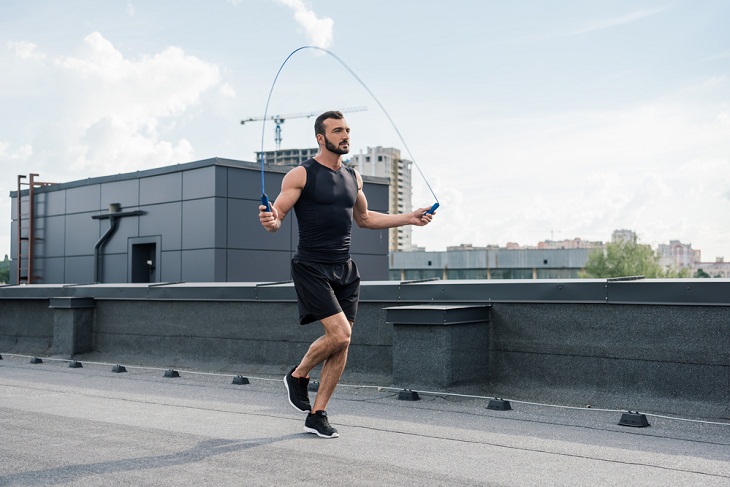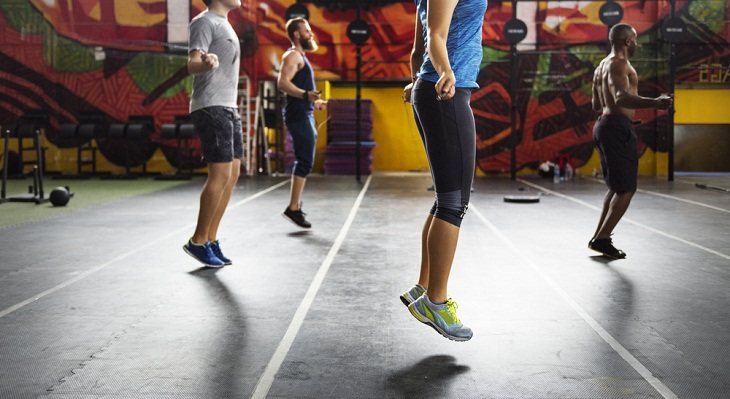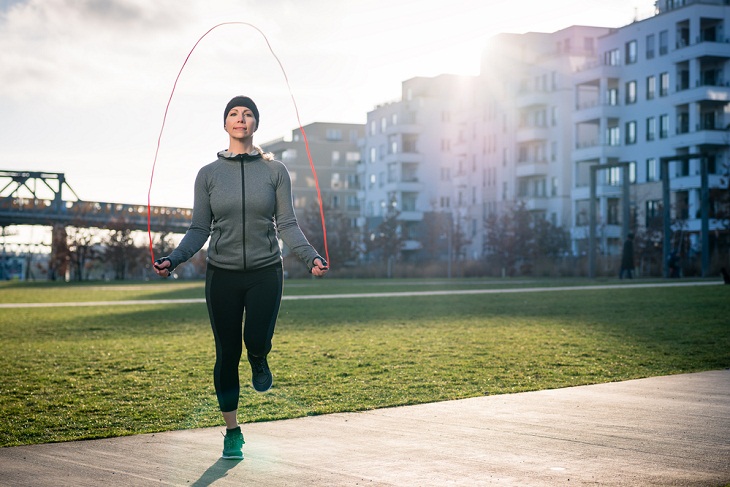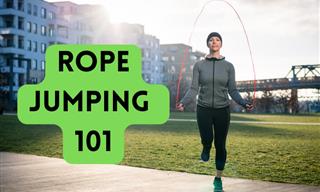Jumping rope is a simple yet highly effective exercise that can help improve your health and fitness. This activity has been popular among boxers and athletes for decades because of its ability to build endurance, coordination, and agility. But it's not just for athletes anymore – skipping rope has become a popular workout choice for anyone looking to boost their overall fitness level. In this article, we will explore the many benefits of jumping rope and provide helpful tips for beginners who want to get started with this fun and challenging exercise.
Whether you are looking to improve your cardiovascular health, burn calories, or just mix up your workout routine, jumping rope may be just what you need.
Related: This is Jump Rope on a Level You Cannot Imagine!
1. Great for the heart

By increasing your heart rate, jumping rope can improve your cardiovascular system and increase your V02 max, which is the maximum amount of oxygen that your body can utilize during exercise. This results in increased cardiovascular endurance, making it easier for you to perform physical activities.
Recent studies have also shown that jumping rope can be particularly beneficial for those at risk of cardiovascular disease. In a 2019 study, college-aged men who did two daily sessions of jumping rope for 12 weeks had improved V02 max and functional movement compared to those who stuck to their usual fitness routines. Similarly, a 2018 study found that a 12-week jump rope regimen reduced cardiovascular disease risk factors in teenage girls with prehypertension. At the end of the study, the girls who jumped rope had lower overall body fat, less abdominal fat, and a better pulse rate, all of which contributed to better heart health. Therefore, skipping rope can be an effective way to reduce the risk of cardiovascular disease and improve heart health.
2. Improves balance
Jumping rope requires you to stay upright and maintain a strong core while also keeping your balance in check between each jump. This combination of skills can help improve your overall balance and coordination, making it a great exercise for athletes and non-athletes alike.
Moreover, jumping rope can also help strengthen the muscles that are responsible for balance, such as the core and lower body muscles. By targeting these muscle groups, you can improve your stability and reduce the risk of falls and injuries. Incorporating jumping rope into your fitness routine can be a fun and effective way to enhance your balance and coordination while also providing numerous other health benefits.
3. Builds bone density

By putting stress on the bones, jumping rope stimulates bone growth and increases bone density, which can reduce the risk of fractures and osteoporosis later in life. This benefit is especially important for girls and women, who are more likely to experience bone loss and fractures as they age.
Several studies have confirmed the positive impact of jumping rope on bone health. For instance, a 2017 study found that girls aged 11 to 14 who participated in weekly jump roping had higher bone density than those who did not do the exercise. Furthermore, the Korean Society for Bone and Mineral Research recommended in 2019 that people jump rope for 10 minutes a day to improve bone strength.
The International Osteoporosis Foundation suggests that people with weak bones may benefit from jumping rope, but it's essential to seek medical advice before starting this exercise. While jumping rope can be beneficial for bone health, it can also increase the risk of injury if not performed correctly. Therefore, it is critical to start slowly and gradually increase the intensity and duration of your workouts under the guidance of a qualified fitness professional.
4. Burns calories fast
With the ability to burn up to 300 calories in just 15 minutes, skipping rope is an excellent way to maximize your workout and achieve your weight loss goals. Notably, it burns more calories than most other continuous cardio exercises, including jogging, cycling, and swimming, making it a popular choice among fitness enthusiasts.
One of the reasons why jumping rope is so effective at burning calories is that it engages multiple muscle groups simultaneously, resulting in a thermogenic effect that raises your body's core temperature and boosts your metabolism. As a result, your body needs to burn more fuel to produce the energy required for the activity, leading to a higher caloric burn. Additionally, jumping rope can be challenging, especially for beginners, as it requires significant cardiovascular endurance and muscle strength. This increased demand for energy further enhances exercise's calorie-burning potential.
It is important to note, however, that jumping rope alone is not a magic weight loss cure. To achieve sustainable results, it is necessary to combine regular exercise with a healthy diet and lifestyle habits. By incorporating jumping rope into your fitness routine and making other positive changes to your daily routine, you can achieve your weight loss and fitness goals and enjoy the many benefits of improved health and well-being.
Related: These Elastic Bands Are the Best Workout Tool for Seniors
5. Improves coordination

The rhythmic cadence required in jump roping challenges your ability to maintain balance, coordination, and agility. It demands precise timing, hand-eye coordination, and body awareness. As a result, regular jump roping can improve your motor skills and spatial awareness, making you more agile and coordinated.
Learning to skip over the rope in time with the rhythm can also enhance your footwork patterns and overall hand-eye coordination, say experts. It requires concentration and mental focus, which can help develop mind-muscle connections and improve reaction time. Moreover, jumping rope is a form of low-impact activity that can be enjoyed by individuals of any age or fitness level, making it an excellent option for promoting coordination and agility while minimizing joint stress.
6. Enhances agility
Fitness professionals say that jumping up and down and adapting to the rope's swinging can help you develop better agility. In fact, a recent study found that agility-based training, which included jumping exercises similar to jumping rope, was just as effective as traditional strength and balance training in improving physical performance, especially lower body explosive strength, in seniors.
Moreover, having increased agility can benefit your overall health beyond just your workouts. It can help you maintain good posture and alignment in your body and improve your reflexes, making it easier to avoid injury. Additionally, being agile can also improve your balance and coordination, making daily activities easier and more enjoyable.
7. Reduces stress
A skipping rope workout releases endorphins, the body's natural mood boosters, which reduce stress. In a 2021 study published in the journal Brain Sciences, researchers found that jumping rope was effective in decreasing anxiety levels among participants. Regular exercise trains your body to adapt to stress and better handle the fight or flight response, which can ultimately help to decrease your overall stress levels and improve your long-term health outcomes. Furthermore, jumping rope outdoors provides an opportunity for exposure to natural light and fresh air, which can reduce stress and promote relaxation.
Skipping rope is a form of physical activity that can be done in a group or alone, making it a convenient stress-busting exercise. Additionally, as you get better at jumping rope, you can challenge yourself by learning new tricks and routines, which can improve your mood and reduce stress levels.
8. Provides a total body workout

Jumping rope is a total body workout that activates both upper and lower muscle groups in the body. With each jump, your calves, hamstrings, and glutes engage to stabilize your body, while your shoulders, biceps, and triceps work to hold the rope and maintain proper form.
Aside from improving lean muscle mass, jumping rope is also an effective means of increasing cardiovascular endurance. Because it is a high-intensity exercise, it can help you burn calories quickly and efficiently, making it a great option for those looking to lose weight or maintain a healthy body weight. Furthermore, the low-impact nature of skipping rope means it is less stressful on your joints than other exercises like running or jumping jacks.
9. It’s an engaging and entertaining workout

Sticking to the same workout routine, such as jogging on a treadmill or cycling on a stationary bike, can get monotonous over time. However, incorporating a jump rope into your fitness plan can revitalize your exercise regimen.
Jumping rope not only offers an entertaining alternative to other workouts, but also provides various health benefits as we already mentioned above.
Additionally, there's never a dull moment when it comes to jump rope workouts, with an abundance of variations and techniques to keep you engaged. You can try jumping at different speeds, experiment with diverse footwork patterns, and even attempt "double unders" or "cross-overs" to push yourself (more on that later).
Jump rope workouts are also beneficial for anyone looking to boost their mental focus and concentration. Since it requires complete attention, you will remain attentive throughout your workout.
So, instead of dreading your daily fitness routine, consider jumping rope to add some excitement and joy to your exercise regime.
Related: Get Started on a Cardio Workout with These Beginner Tips
How to jump rope: A step-by-step explainer

Jump roping is a skill that not everyone is proficient in, despite having learned it in their childhood. Unlike cycling, jumping rope may require a greater level of practice and perseverance to master, but the results can be rewarding.
Experts recommend the following instructions for jumping rope.
1. Choose the right rope: There are many types of jump ropes available on the market, from basic ropes to weighted and adjustable ones. Pick a rope appropriate for your skill level and workout goals. A good rule of thumb is to choose a rope that is long enough to reach your armpits when you stand on it.
2. Find the right space: You will need a space that is at least as wide and long as your extended arms, and ideally, with a low ceiling. You should have enough space to swing the rope without hitting any obstacles or other people.
3. Adjust the rope length: If your rope is adjustable, ensure that it is adjusted according to your height. To do this, step on the rope with both feet, and pull the handles up to your armpits. If the rope is too long or too short, adjust it until it's the right length.
4. Get in the right stance: Stand with your feet shoulder-width apart and your knees slightly bent. Hold the rope handles at waist height, with your elbows close to your body. Keep your head up and your gaze forward.
5. Practice basic jumps: Take hold of the two ends of a jump rope with your hands and place the rope's loop on the ground behind you. Now, start with basic jumps, also known as "single unders." Swing the rope over your head, and jump over it as it passes under your feet. Land lightly on the balls of your feet, and keep your body relaxed and upright.
6. Progress to more advanced jumps: Once you've mastered the basic jump, you can progress to more advanced jumps, such as "double unders" and "cross-overs." Double unders involve swinging the rope twice under your feet with each jump, while cross-overs involve crossing your arms in front of your body as you jump.
7. Incorporate interval training: To increase the intensity of your workout, you can incorporate interval training. Alternate between high-intensity jumping and low-intensity rest periods, such as jumping for 30 seconds and resting for 10 seconds.
8. Cool down and stretch: After your workout, take a few minutes to cool down and stretch your muscles. This can help reduce soreness and prevent injury.
 Go to BabaMail
Go to BabaMail






























